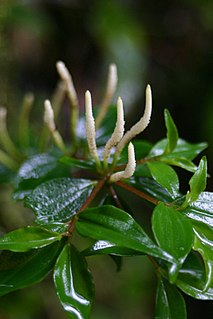
Peperomia is one of the two large genera of the family Piperaceae. Most of them are compact, small perennial epiphytes growing on rotten wood. More than 1500 species have been recorded, occurring in all tropical and subtropical regions of the world, though concentrated in Central America and northern South America. A limited number of species are found in Africa.

Carambola, also known as star fruit or 5 fingers, is the fruit of Averrhoa carambola, a species of tree native to tropical Southeast Asia. The fruit is commonly consumed in parts of Brazil, Southeast Asia, South Asia, the South Pacific, Micronesia, parts of East Asia, the United States, and the Caribbean. The tree is cultivated throughout tropical areas of the world.

Guava is a common tropical fruit cultivated in many tropical and subtropical regions. The common guava Psidium guajava is a small tree in the myrtle family (Myrtaceae), native to Mexico, Central America, the Caribbean and northern South America. Related plants may also be called guavas; they belong to other species or genera, such as the pineapple guava, Feijoa sellowiana. In 2019, 55 million tonnes of guavas were produced worldwide, led by India with 45% of the total. Botanically, guavas are berries.

Annona is a genus of flowering plants in the pawpaw/sugar apple family, Annonaceae. It is the second largest genus in the family after Guatteria, containing approximately 166 species of mostly Neotropical and Afrotropical trees and shrubs.

Solanum viarum, the tropical soda apple, is a perennial shrub native to Brazil and Argentina with a prickly stem and prickly leaves. The fruit is golf-ball-sized with the coloration of a watermelon. It is considered an invasive species in the lower eastern coastal states of the United States and recently on the Mid North Coast of Australia.

Annona squamosa is a small, well-branched tree or shrub from the family Annonaceae that bears edible fruits called sugar-apples or sweetsops. It tolerates a tropical lowland climate better than its relatives Annona reticulata and Annona cherimola helping make it the most widely cultivated of these species. Annona squamosa is a small, semi-(or late) deciduous, much branched shrub or small tree 3 metres (9.8 ft) to 8 metres (26 ft) tall similar to soursop.

The National Tropical Botanical Garden (NTBG) is a Hawaii-based not-for-profit institution dedicated to tropical plant research, conservation, and education. It operates a network of botanical gardens and preserves in Hawaii and Florida.

Syzygium malaccense is a species of flowering tree native to Malesia and Australia. It is one of the species cultivated since prehistoric times by the Austronesian peoples. They were carried and introduced deliberately to Remote Oceania as canoe plants. In modern times, it has been introduced throughout the tropics, including many Caribbean countries and territories.

Casasia is a genus of flowering plants in the family Rubiaceae. These shrubs or small trees occur on the Caribbean islands and in one case in Florida. Some of the ten accepted species were formerly placed elsewhere, e.g. in the related genip-tree genus (Genipa), in Gardenia or in Randia.

Ficus americana, commonly known as the West Indian laurel fig or Jamaican cherry fig, is a tree in the family Moraceae which is native to the Caribbean, Mexico in the north, through Central and South America south to southern Brazil. It is an introduced species in Florida, USA. The species is variable; the five recognised subspecies were previously placed in a large number of other species.

Aellopos tantalus, known as the Tantalus sphinx, is a moth of the family Sphingidae. It is found in Florida, the Antilles, from Mexico to Venezuela, Colombia, Ecuador, Suriname, and in the Amazon basin.

Clusia rosea, the autograph tree, copey, cupey, balsam apple, pitch-apple, and Scotch attorney, is a tropical and sub-tropical plant species in the genus Clusia. The name Clusia major is sometimes misapplied to this species.

Solanum tampicense, also known as wetland nightshade, aquatic soda apple, and scrambling nightshade, is a perennial in the Solanaceae or Nightshade Family. It can exist as a vine, tree, or shrub and is native to the West Indies and Central America. It is classified as a noxious weed by the United States Department of Agriculture and by several states and is known as an invasive species in the state of Florida.

Gratiana boliviana is a species of beetle in the leaf beetle family, Chrysomelidae. Its common name is tropical soda apple leaf beetle. It is native to South America, where its distribution includes Argentina, Brazil, and Paraguay. It specializes on tropical soda apple, an invasive plant species. It has been released as an agent of biological pest control against the weedy plant in Florida and other parts of the United States.
Casasia calophylla, is a species of plant belonging to the family Rubiaceae, it is native to Cuba.
Casasia domingensis is a plant native to the Dominican Republic, it is a part of the family Rubiaceae.
Casasia ekmanii is a plant belonging to the family Rubiaceae, it is native to Haiti.
Casasia jacquinioides is a species of plant belonging to the family Rubiaceae.
Casasia samuelssonii is a plant belonging to the family Rubiaceae. It is found in the Dominican Republic.
Dystovomita is a genus of flowering plants belonging to the family Clusiaceae.














